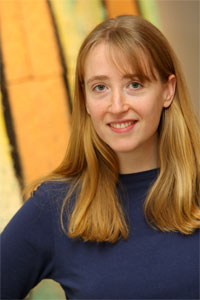 |
| Jennifer Ford is a coauthor of the study Aquaculture Impacts on Wild Salmon. (Nick Pearce Photo) |
A study appearing in the December 14 issue of the journal Science shows that parasitic sea lice infestations caused by salmon farms are killing off nearby populations of wild salmon. The startling results show that wild salmon which swim in proximity to farmed salmon have been in rapid decline over the past four years. Scientists expect a near complete — 99 per cent — collapse of wild salmon stocks in four years, or in two salmon generations, if the infestations continue.
“This is the first demonstration that these large fish farms are having an impact, and are, in fact driving wild stocks to extinction,” says Jennifer Ford, who worked on the study as a Master’s student at В鶹ґ«ГЅ. Her supervisor and one of the study’s co-authors was the late Ransom Myers, to whom the paper is dedicated.
“These fish can’t sustain this level of mortality and we’d like to see DFO (Department of Fisheries and Oceans) admit to what’s happening and do something about it because all they’ve managed to do so far is stall,” says Ms. Ford, a fisheries scientist at the Ecology Action Centre in Halifax. “So, we need a recognition that the situation has to change and fast. We can’t wait four more years for more information … the salmon just don’t have that much time.”
See additional photos: Impacts of aquaculture on wild fish.
The study examines the impact of parasitic sea lice from salmon farms on wild pink salmon populations in the Broughton Archipelago, along the central British Columbia coast. The researchers, both biologists and statisticians, analyzed Canadian government data on the number of pink salmon returning to rivers in the area from 1970 to 2006. They also actually counted lice on adult and juvenile salmon at various points along the salmon’s migration routes: at the mouth of the river, down the route after they’ve passed the farms, and at the ocean.
The salmon louse is a major parasite of farmed salmon. As a juvenile, the louse drifts through the water seeking host fish. When it finds a fish, it latches on the outside and feeds on skin, muscle and blood. Large adult salmon have thick scales, and can survive sea lice infestations. But small juvenile salmon, which do not have scales, are more likely to die. They are infected as they swim in rivers past fish farms on their journey to the ocean.
“They are just tiny, about the size of a paper clip, and they’ll have these big suckers eating their skin,” says Ms. Ford. "Once the (sea lice) eat through their skin, the juveniles will get other infections and die. The adult salmon can withstand the lice, but the juveniles, as they swim to the ocean in the spring, are really vulnerable.”
Sea lice, Ms. Ford notes, are naturally occurring in the wild. “But, when you get a salmon farm with one million fish in a pen, the natural phenomena is amplified.”
The researchers observed when farms on a primary migration route were temporarily shut down, sea lice numbers dropped and salmon populations rebounded.
Proposed solutions include moving farms away from rivers or closed containment for farmed salmon; that is, moving the salmon to pens that are completely sealed off from the surrounding environment in contrast to the open-net pens currently in use.
Even though the study was focused on west-coast salmon populations, it has implications in other coastal areas where wild fish come in contact with farmed fish. Ian Fleming, professor at the Ocean Sciences Centre at Memorial University of Newfoundland, says the findings reinforce studies done on brown trout in Ireland in the mid-1990s.
“I think one of the critical issues here is the density of fish farms,” says Dr. Fleming, who was not involved with the study. “And that be an issue (with Atlantic salmon) in the Bay of Fundy, where there is a high level of fish farming."
Besides Ms. Ford and the late Dr. Myers, other co-authors of Aquaculture Impacts on Wild Salmon are Martin Krkosek, PhD candidate at the University of Alberta; Alexandra Morton, executive director of the Raincoast Research Society and director of the Salmon Coast Field Station in Simoom Sound, B.C.; Subhash Lele, professor at the University of Alberta; and Mark Lewis, Canada Research Chair in Mathematical Biology at the University of Alberta.
